Individualized cancer therapy
A recent trend in cancer treatment has been termed individualized or targeted therapy and has the goal of matching cancer treatment to the characteristics of the patient and the biologic features of his or her tumor ( ). As cancer treatment moves toward more targeted and individualized therapy, there is an increasing need for tools to guide therapy selection and to evaluate response. In particular, to make appropriate choices for therapy, the cancer physician needs to know the following:
1 How aggressive is the cancer? How likely is it that the cancer will spread and/or cause symptoms or death?
2 What are appropriate targets for cancer therapy? Are the targets expressed by the tumor? Are there resistance factors that may mitigate the success of the treatment? Has the target been suppressed?
3 Is the tumor responding? Can a lack of response for ineffective therapy be identified quickly so that alternative treatment can be tried?
The current approach to patient management relies upon a combination of imaging and biopsy to detect, localize, and confirm tumors and upon in vitro assay of biopsy material to determine tumor biologic features. Relying entirely upon tissue sampling to characterize tumors has two important limitations:
Get Radiology Tree app to read full this article<
Get Radiology Tree app to read full this article<
The approach to cancer imaging
Get Radiology Tree app to read full this article<
Get Radiology Tree app to read full this article<
Get Radiology Tree app to read full this article<
Get Radiology Tree app to read full this article<
Approaches to clinical study design and analysis
Get Radiology Tree app to read full this article<
Get Radiology Tree app to read full this article<
Get Radiology Tree app to read full this article<
Get Radiology Tree app to read full this article<
Get Radiology Tree app to read full this article<
Get Radiology Tree app to read full this article<
Get Radiology Tree app to read full this article<
Applications of molecular imaging to cancer prognosis, prediction, and response
Prognosis
Get Radiology Tree app to read full this article<
Get Radiology Tree app to read full this article<
Get Radiology Tree app to read full this article<
Prediction
Get Radiology Tree app to read full this article<
Get Radiology Tree app to read full this article<
Get Radiology Tree app to read full this article<
Get Radiology Tree app to read full this article<
Get Radiology Tree app to read full this article<
Response
Get Radiology Tree app to read full this article<
Get Radiology Tree app to read full this article<
Get Radiology Tree app to read full this article<
Get Radiology Tree app to read full this article<
Get Radiology Tree app to read full this article<
Get Radiology Tree app to read full this article<
Get Radiology Tree app to read full this article<
Summary
Get Radiology Tree app to read full this article<
Get Radiology Tree app to read full this article<
References
1. Kaklamani V., O’Regan R.M.: New targeted therapies in breast cancer. Semin Oncol 2004; 31: pp. 20-25.
2. Sawyers C.L.: Making progress through molecular attacks on cancer. Cold Spring Harb Symp Quant Biol 2005; 70: pp. 479-482.
3. Beckman R.A., Loeb L.A.: Genetic instability in cancer: Theory and experiment. Semin Cancer Biol 2005; 15: pp. 423-435.
4. Aboagye E.O., Price P.M.: Use of positron emission tomography in anticancer drug development. Investig New Drugs 2003; 21: pp. 169-181.
5. Kelloff G.J., Hoffman J.M., Johnson B., Scher H.I., Siegel B.A., Cheng E.Y., et. al.: Progress and promise of FDG-PET imaging for cancer patient management and oncologic drug development. Clin Cancer Res 2005; 11: pp. 2785-2808.
6. Kelloff G.J., Krohn K.A., Larson S.M., Weissleder R., Mankoff D.A., Hoffman J.M., et. al.: The progress and promise of molecular imaging probes in oncologic drug development. Clin Cancer Res 2005; 11: pp. 7967-7985.
7. Alessio A.M., Kinahan P.E., Cheng P.M., Vesselle H., Karp J.S.: PET/CT scanner instrumentation, challenges, and solutions. Radiol Clin North Am 2004; 42: pp. 1017-1032.
8. Leach M.O., Brindle K.M., Evelhoch J.L., Griffiths J.R., Horsman M.R., Jackson A., et. al.: The assessment of antiangiogenic and antivascular therapies in early-stage clinical trials using magnetic resonance imaging: Issues and recommendations. Br J Cancer 2005; 92: pp. 1599-1610.
9. Shankar L.K., Hoffman J.M., Bacharach S., Graham M.M., Karp J., Lammertsma A.A., et. al.: Consensus recommendations for the use of 18 F-FDG PET as an indicator of therapeutic response in patients in National Cancer Institute Trials. J Nucl Med 2006; 47: pp. 1059-1066.
10. Lehman C.D.: Screening MRI for women at high risk for breast cancer. Semin Ultrasound CT MR 2006; 27: pp. 333-338.
11. Warner E., Plewes D.B., Hill K.A., Causer P.A., Zubovits J.T., Jong R.A., et. al.: Surveillance of BRCA1 and BRCA2 mutation carriers with magnetic resonance imaging, ultrasound, mammography, and clinical breast examination. JAMA 2004; 292: pp. 1317-1325.
12. Hartwell L., Mankoff D., Paulovich A., Ramsey S., Swisher E.: Cancer biomarkers: A systems approach. Nat Biotechnol 2006; 24: pp. 905-908.
13. Pinder S.E., Wencyk P., Sibbering D.M., et. al.: Assessment of the new proliferation marker MIB1 in breast carcinoma using image analysis: Associations with other prognostic factors and survival. Br J Cancer 1995; 71: pp. 146-149.
14. Sledge G.J., McGuire W.: Steroid hormone receptors in human breast cancer. Adv Cancer Res 1983; 38: pp. 61-75.
15. Therasse P., Arbuck S.G., Eisenhauer E.A., Wanders J., Kaplan R.S., Rubinstein L., et. al.: New guidelines to evaluate the response to treatment in solid tumors. J Natl Cancer Inst 2000; 92: pp. 205-216.
16. Scher H.I., Morris M.J., Kelly W.K., Schwartz L.H., Heller G.: Prostate cancer clinical trial end points: “RECIST”ing a step backwards. Clin Cancer Res 2005; 11: pp. 5223-5232.
17. Yarden Y.: The EGFR family and its ligands in human cancer: Signalling mechanisms and therapeutic opportunities. Eur J Cancer 2001; 37: pp. S3-S8.
18. Eary J.F., O’Sullivan F., Powitan Y., et. al.: Sarcoma tumor FDG uptake measured by PET and patient outcome: A retrospective analysis. Eur J Nucl Med Mol Imaging 2002; 29: pp. 1149-1154.
19. Hawkins D.S., Schuetze S.M., Butrynski J.E., et. al.: [ 18 F]Fluoro-deoxyglucose positron emission tomography predicts outcome for Ewing sarcoma family of tumors. J Clin Oncol 2005; 23: pp. 8828-8834.
20. Oshida M., Uno K., Suzuki M., Nagashima T., Hashimoto H., Yagata H., et. al.: Predicting the prognoses of breast carcinoma patients with positron emission tomography using 2-deoxy-2-fluoro[ 18 F]-D-glucose. Cancer 1998; 1: pp. 2227-2234.
21. Patronas N.J., Di Chiro G., Kufta C., et. al.: Prediction of survival in glioma patients by means of positron emission tomography. J Neurosurg 1985; 62: pp. 816-822.
22. Tralins K.S., Douglas J.G., Stelzer K.J., Mankoff D.A., Silbergeld D.L., Rostomily R.C., et. al.: Volumetric analysis of 18 F-FDG PET in glioblastoma multiforme: Prognostic information and possible role in definition of target volumes in radiation dose escalation. J Nucl Med 2002; 43: pp. 1667-1673.
23. Vansteenkiste J., Fischer B.M., Dooms C., Mortensen J.: Positron-emission tomography in prognostic and therapeutic assessment of lung cancer: Systematic review. Lancet Oncol 2004; 5: pp. 531-540.
24. Robbins R.J., Wan Q., Grewal R.K., Reibke R., Gonen M., Strauss H.W., et. al.: Real-time prognosis for metastatic thyroid carcinoma based on 2-[ 18 F]fluoro-2-deoxy-D-glucose-positron emission tomography scanning. J Clin Endocrinol Metab 2006; 91: pp. 498-505.
25. Dehdashti F., Grigsby P.W., Mintun M.A., Lewis J.S., Siegel B.A., Welch M.J.: Assessing tumor hypoxia in cervical cancer by positron emission tomography with 60 Cu-ATSM: relationship to therapeutic response: A preliminary report. Int J Radiat Oncol Biol Phys 2003; 55: pp. 1233-1238.
26. Rajendran J.G., Schwartz D.L., O’Sullivan J., Peterson L.M., Ng P., Scharnhorst J., et. al.: Tumor hypoxia imaging with F-18 FMISO PET in head and neck cancer: Value of pre-therapy FMISO uptake in predicting survival. Clin Cancer Res 2006; 5: pp. 5435-5441.
27. Campbell F.C., Elston C.W., Blamey R.W., et. al.: Quantitative oestradiol receptor values in primary breast cancer and response of metastases to endocrine therapy. Lancet 1981; 1: pp. 1317-1319.
28. Cascinu S., Aschele C., Barni S., Debernardis D., Baldo C., Tunesi G., et. al.: Thymidylate synthase protein expression in advanced colon cancer: Correlation with the site of metastasis and the clinical response to leucovorin-modulated bolus 5-fluorouracil. Clin Cancer Res 1999; 5: pp. 1996-1999.
29. Pegram M.D., Konecny G.E., O’Callaghan C., Beryt M., Pietras R., Slamon D.J.: Rational combinations of trastuzumab with chemotherapeutic drugs used in the treatment of breast cancer. J Natl Cancer Inst 2004; 96: pp. 739-749.
30. Linden H.M., Stekhova S.A., Link J.M., Gralow J.R., Livingston R.B., Ellis G.K., et. al.: Quantitative fluoroestradiol positron emission tomography imaging predicts response to endocrine treatment in breast cancer. J Clin Oncol 2006; 24: pp. 2793-2799.
31. Mortimer J.E., Dehdashti F., Siegel B.A., Trinkaus K., Katzenellenbogen J.A., Welch M.J.: Metabolic flare: Indicator of hormone responsiveness in advanced breast cancer. J Clin Oncol 2001; 19: pp. 2797-2803.
32. Dimitrakopoulou-Strauss A., Strauss L.G., Schlag P., et. al.: Fluorine-18-fluorouracil to predict therapy response in liver metastases from colorectal carcinoma. J Nucl Med 1998; 39: pp. 1197-1202.
33. Wolf W., Presant C.A., Waluch V.: 19F-MRS studies of fluorinated drugs in humans. Adv Drug Deliv Rev 2000; 41: pp. 55-74.
34. Perik P.J., Lub-De Hooge M.N., Gietema J.A., van der Graaf W.T., de Korte M.A., Jonkman S., et. al.: Indium-111-labeled trastuzumab scintigraphy in patients with human epidermal growth factor receptor 2-positive metastatic breast cancer. J Clin Oncol 2006; 24: pp. 2276-2282.
35. Smith-Jones P.M., Solit D.B., Akhurst T., Afroze F., Rosen N., Larson S.M.: Imaging the pharmacodynamics of HER2 degradation in response to Hsp90 inhibitors. Nat Biotechnol 2004; 22: pp. 701-706.
36. Welch D.R.: Microarrays bring new insights into understanding of breast cancer metastasis to bone. Breast Cancer Res 2004; 6: pp. 61-64.
37. Motzer R.J., Hoosen S., Bello C.L., Christensen J.G.: Sunitinib malate for the treatment of solid tumours: A review of current clinical data. Expert Opin Investig Drugs 2006; 15: pp. 553-561.
38. Bast R.C., Ravdin P., Hayes D.F., Bates S., Fritsche H., Jessup J.M., et. al.: 2000 update of recommendations for the use of tumor markers in breast and colorectal cancer: Clinical practice guidelines of the American Society of Clinical Oncology. J Clin Oncol 2001; 19: pp. 1865-1878.
39. Mankoff D.A., Dunnwald L.K., Gralow J.R., Ellis G.K., Schubert E.K., Charlop A.W., et. al.: [Tc-99m]-sestamibi uptake and washout in locally advanced breast cancer are correlated with tumor blood flow. Nucl Med Biol 2002; 29: pp. 719-727.
40. Mankoff D.A., Dunnwald L.K., Gralow J.R., Ellis G.K., Drucker M.J., Livingston R.B.: Monitoring the response of patients with locally advanced breast carcinoma to neoadjuvant chemotherapy using [technetium-99m]-sestamibi scintimammography. Cancer 1999; 85: pp. 2410-2423.
41. Dunnwald L.K., Gralow J.R., Ellis G.K., Livingston R.B., Linden H.M., Lawton T.J., et. al.: Residual tumor uptake of [ 99m Tc]-sestamibi after neoadjuvant chemotherapy for locally advanced breast carcinoma predicts survival. Cancer 2005; 103: pp. 680-688.
42. Stroobants S., Goeminne J., Seegers M., Dimitrijevic S., Dupont P., Nuyts J., et. al.: 18 FDG-Positron emission tomography for the early prediction of response in advanced soft tissue sarcoma treated with imatinib mesylate (Glivec). Eur J Cancer 2003; 39: pp. 2012-2020.
43. Blankenberg F., Ohtsuki K., Strauss H.W.: Dying a thousand deaths. Q J Nucl Med 1999; 43: pp. 170-176.
44. Mankoff D.A., Shields A.F., Krohn K.A.: PET imaging of cellular proliferation. Radiol Clin North Am 2005; 43: pp. 153-167.
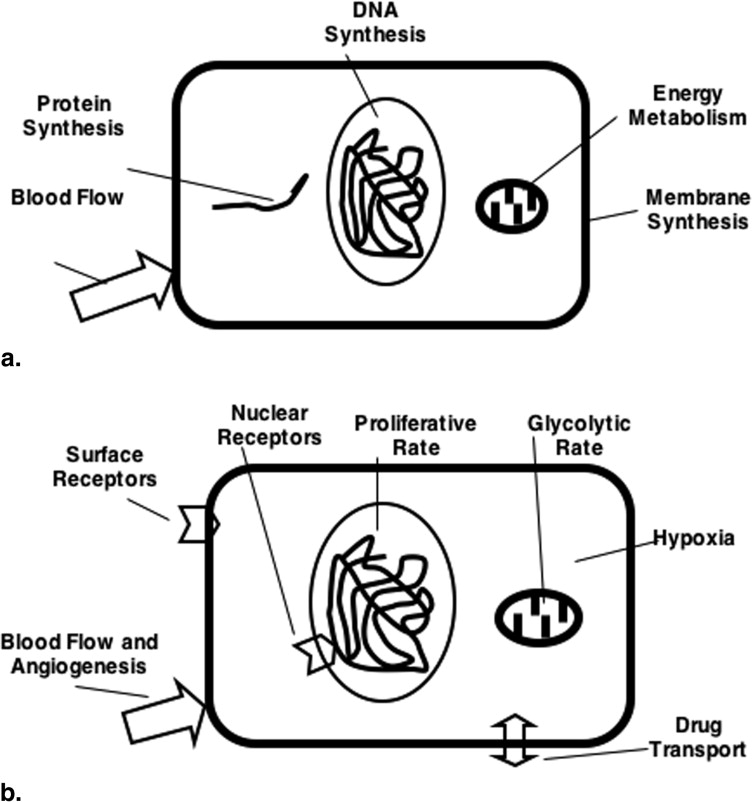
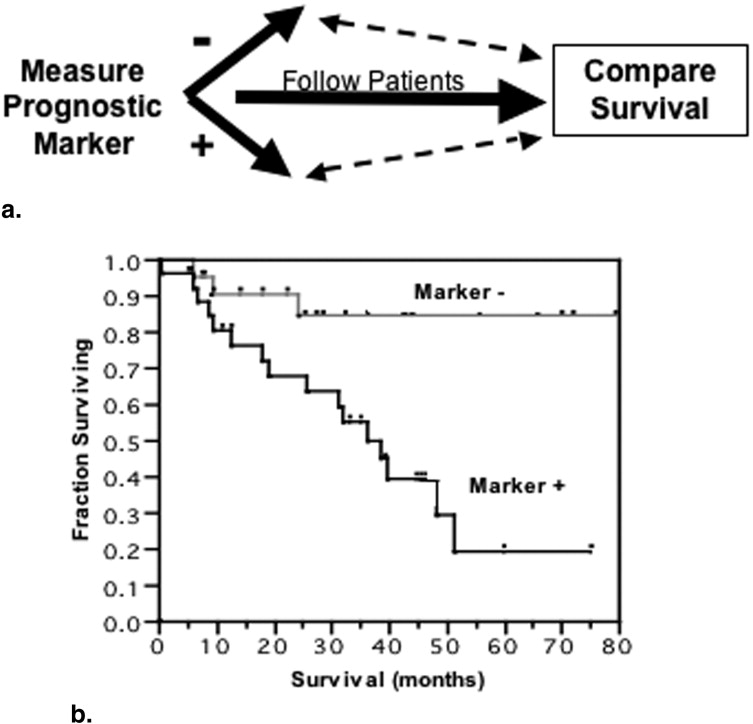

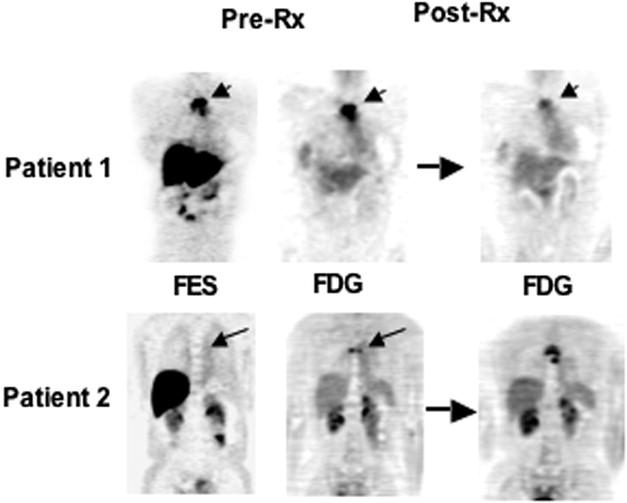
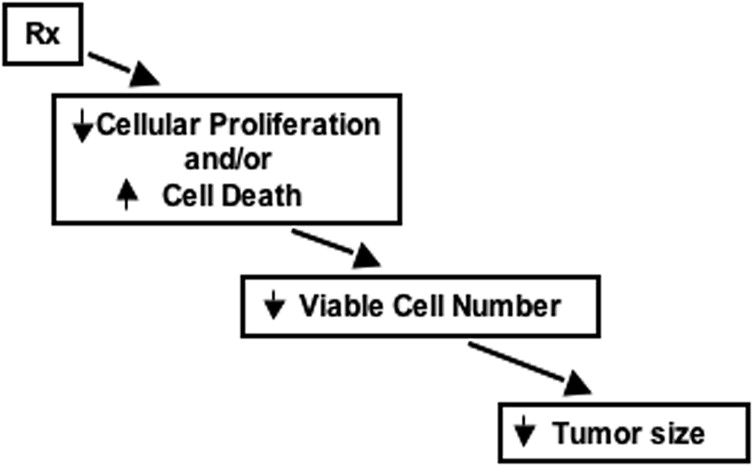
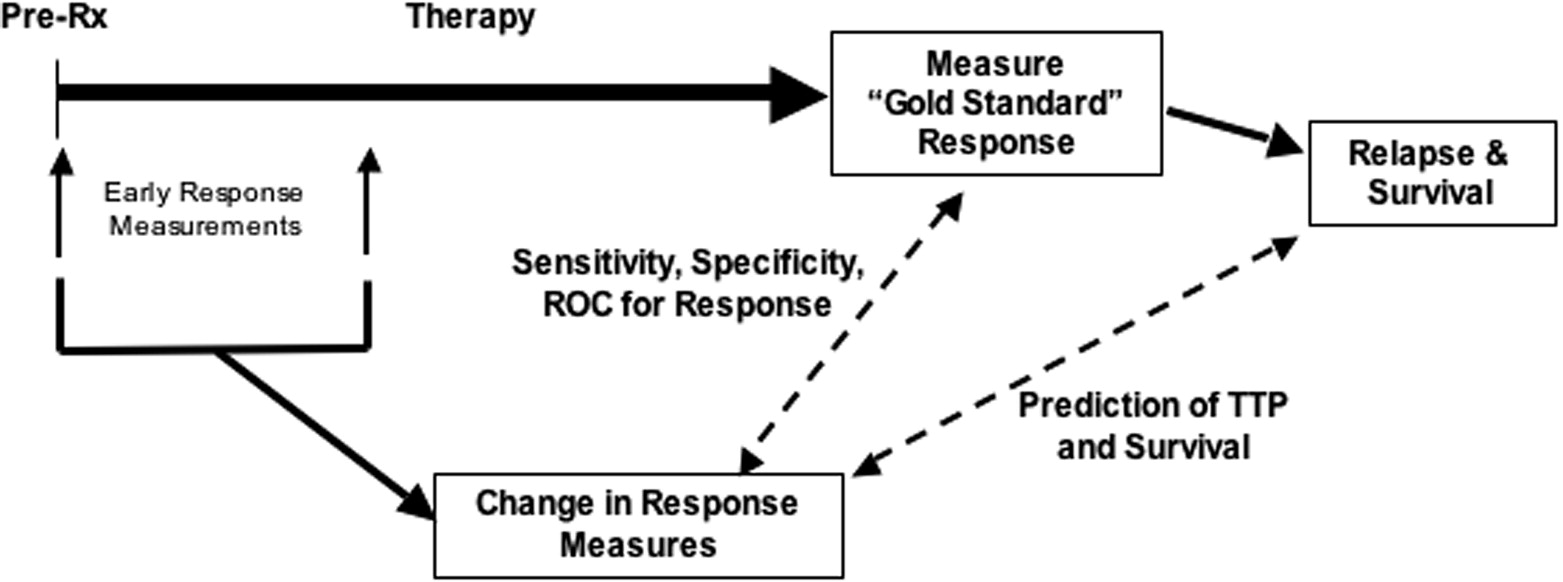
![Figure 7, Illustration of a study testing a novel imaging procedure as a measure of response to therapy. The change in uptake of 99m Tc-sestamibi (MIBI) in locally advanced breast cancer was compared to the “gold standard” response (posttherapy histopathology) (40) and posttherapy MIBI uptake was compared to patient outcome (41). Images ( A ) show the ability to distinguish pathologic complete response (CR) versus partial response (PR), and a plot of the change in MIBI uptake ratios (lesion-to-normal breast uptake [L:N ratio]) shows that values for CR versus PR are nearly completely separated ( B ). ROC analysis depicts the ability to classify CR versus PR based upon the change in MIBI uptake on a plot of the sensitivity for CR versus 1 − specificity ( C ). Comparison of residual MIBI uptake posttherapy to overall survival ( D ) demonstrates that low posttherapy MIBI uptake is predictive of survival.](https://storage.googleapis.com/dl.dentistrykey.com/clinical/MolecularImagingResearchintheOutcomesEra/6_1s20S1076633207000098.jpg)